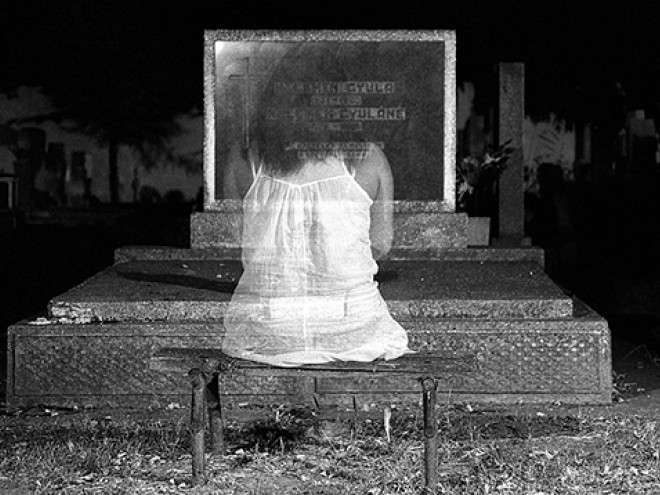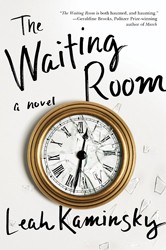Earlier this week, Leah Kaminsky considered the role and of ghosts in contemporary literature—including her own novel, The Waiting Room. Leah is guest blogging for the Jewish Book Council all week as part of the Visiting Scribe series here on The ProsenPeople.
I am a collector, a lover of junk shops, where I can spend hours sifting through old photographs and tchotchkes. Our house looks like the movie set for The Addams Family.
My mother came to Australia as a refugee after World War II, with one small suitcase in her hand. Her only treasure, a tiny marcasite butterfly brooch she had been given after liberation from Bergen-Belsen, when she worked as the secretary of the Jewish Police in the Hohne DP camp. After she died, I wore the brooch all the time. Somehow, transferring her memory by embedding it into this piece of jewelry helped in some small way to make up for the deep loss I felt.
And then one day, our house was burgled. Along with the laptops and gadgetry stolen, my mother’s brooch disappeared. I was bereft, grieving as though she had died a second time.
Lacrimae rerum, Virgil wrote in his epic poem Aeneid. “There are tears in things.” Inanimate objects hold a power to move us; we invest them with such deep emotion that they become symbolic and tangible mementos of what we have lost. Their very physicality seems to bring the dead palpably closer to us through memory, tattooed onto teacups, onto paintings and toys.
 A baby innately wants her mother, or primary caregiver, to be close by at all times — but place a teddy bear in the crib and the infant will quickly learn to cling to the soft toy for comfort, a substitute for the mother’s warmth. This transition object becomes a projection of the mother’s attributes, perhaps the primal need for comfort redirected onto the toy. These kind of objects continue to play an important role for us throughout our lives. We imbue them with memory and meaning.
A baby innately wants her mother, or primary caregiver, to be close by at all times — but place a teddy bear in the crib and the infant will quickly learn to cling to the soft toy for comfort, a substitute for the mother’s warmth. This transition object becomes a projection of the mother’s attributes, perhaps the primal need for comfort redirected onto the toy. These kind of objects continue to play an important role for us throughout our lives. We imbue them with memory and meaning.
My teddy-bear, Tichy, was able to do headstands as well as the splits. And of course, he could talk, although it was always in the faintest of whispers only I could hear. Bun, my daughter’s rabbit, has his bottom rubbed smooth, a furless ring worn around his tail. His face is squashed to one side, his long ears shriveled, black eyes filled with years of love. He has been her companion since she was born, running laps around her cot, then falling out of the side of her bed, getting lost on escalators at the airport, skydiving out open bedroom windows, dunked in swimming pools and pegged by his ears to the washing line to dry. Those same ears listened to my daughter sing herself to sleep at night, wake in the morning laughing, shifting from one language to another as we migrated across the globe. She suffused him with a huge personality for a tiny stuffed toy. They have stuck together through summer camps, hidden at the bottom of her bag so her bunkmates wouldn’t know. Bun lay there in the dark, silently guarding her childhood from drifting away. Back home, sitting on her bed, propped up against a pillow, he watched her grow from baby into child, from girl into woman. Quietly waiting for her to leave him behind, old ragged Bun lets her go now, knowing she will return even though she doesn’t need him anymore. Sometimes, when she’s out, I tiptoe into her room and hold Bun close to my heart, breathing in his faded smell as I greedily try to hoard the past.
Love lies hidden in the memory of objects that people we have loved once held dear, or which have taken on a special significance since their death. Maybe this is why I can’t let go of the spectacles my father wore when he used to read me bedtime stories, or my mother’s old flour sifter with which she prepared her delicious apricot cakes.
Forgetting, or letting go of the presence of the dead can sometimes be more painful than holding on to their memory through transference onto an object. “I remember phone numbers of the dead,” says my 94-year-old painter friend, Yosl Bergner. He can’t cross his friends out in his little black phone book. “It’s as if they have died twice if I do; only the second time, I’ve killed them by erasing their memory.”
My novel The Waiting Room is crowded with objects: uncaptioned photographs, old shoes, a glass eyewash cup, letters in Yiddish hidden away and discovered in an old tin. Like me, its protagonist, Dina, hoards her dead parents’ indecipherable relics, hoping that one day they will reveal the stories she never wanted to listen to as a young girl. As Ray Bradbury’s grandfather once told him, “Everyone must leave something behind when he dies… Something your hand touched some waysoyoursoulhas somewhere to go… a legacy is etched into the minds of others and the stories they share about you.” In this way, the dead can still be felt amongst the living.
Leah Kaminsky is a physician and author, whose books include We’re All Going to Die, Writer MD, and Cracking the Code. She is the poetry editor for the Medical Journal of Australia.
Related Content:
- Judy Batallion: Stuff: Is It Good for the Jews?
- Francesca Segal: Dating and Doctors
- Marjorie Ingall: Five Reasons My Book Was a Year Late
Leah Kaminsky, physician and award-winning author, is Poetry Editor at the Medical Journal of Australia. Her books include We’re All Going to Die, Writer MD, and Cracking the Code. She holds an MFA in Fiction from Vermont College of Fine Arts.




